Organizational Change Report: Perspectives, Approaches, and Models
VerifiedAdded on 2019/12/03
|8
|2296
|401
Report
AI Summary
This report delves into the multifaceted concept of organizational change, exploring its significance and the various factors that drive it, both internal and external. It examines the differing perspectives on change, particularly contrasting the viewpoints of employees and managers, and how these perspectives shape resistance or acceptance. The report then provides a comprehensive overview of two primary approaches to change: planned and emergent. It details the characteristics and applications of each, including practical examples like Maruti Suzuki's Nexa franchise and Nokia's shift to Microsoft. Furthermore, the report analyzes several key models for change management, such as Lewin's three-step model, Kotter's eight-step model, and the McKinsey 7-S model, highlighting their strengths, weaknesses, and practical implications. The conclusion emphasizes the importance of timely change implementation to ensure sustainability, ethical practices, and overall organizational success.
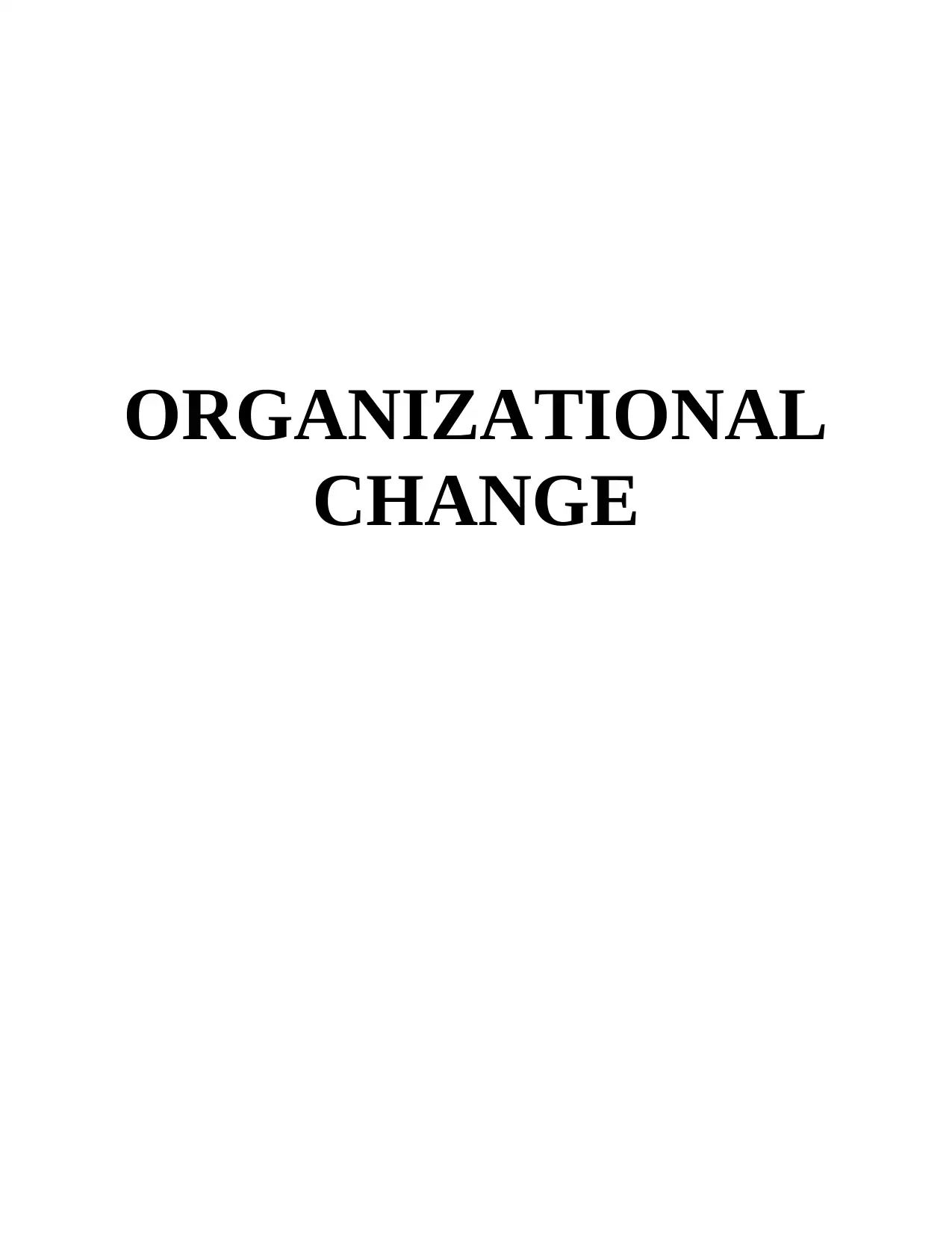
ORGANIZATIONAL
CHANGE
CHANGE
Paraphrase This Document
Need a fresh take? Get an instant paraphrase of this document with our AI Paraphraser
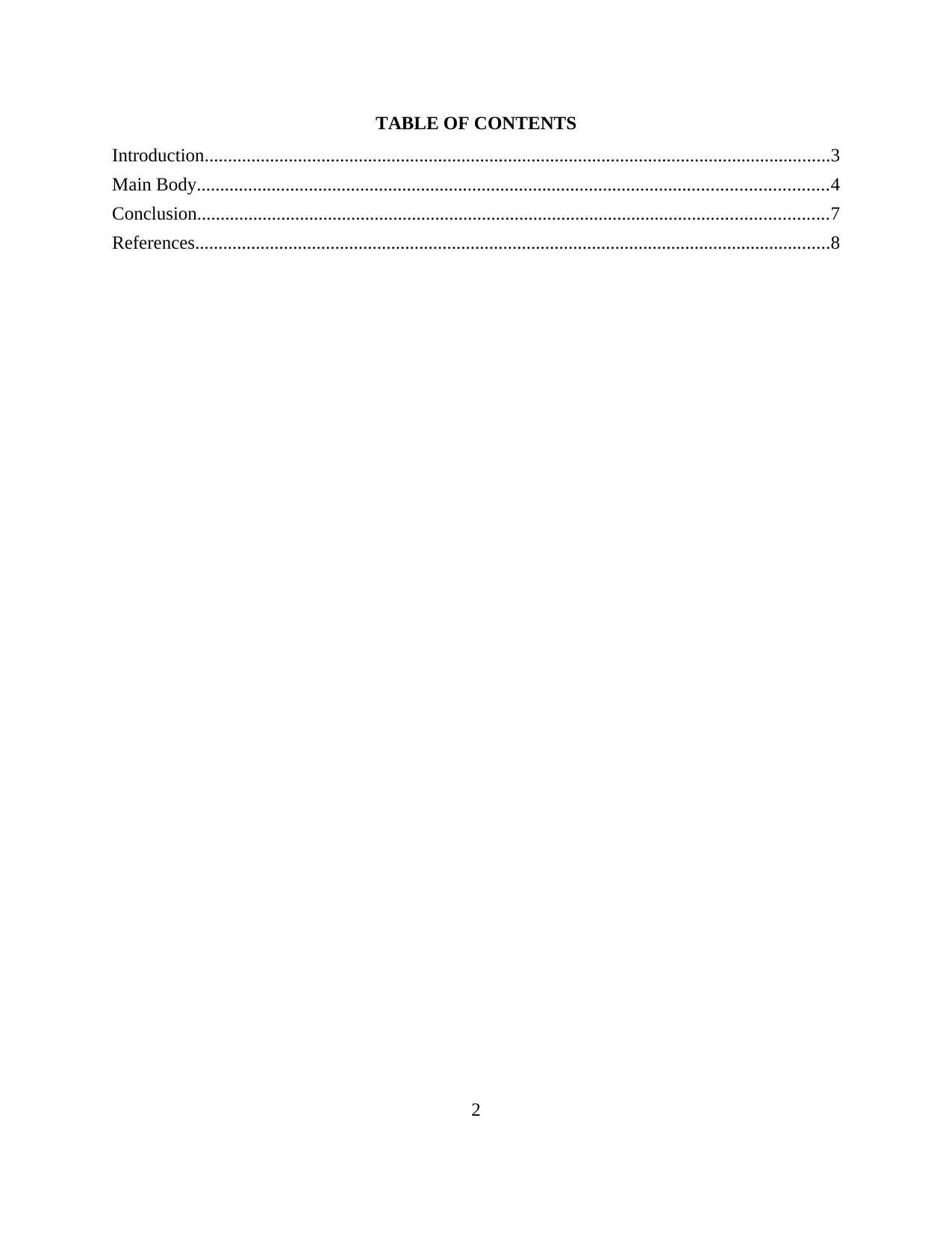
TABLE OF CONTENTS
Introduction......................................................................................................................................3
Main Body.......................................................................................................................................4
Conclusion.......................................................................................................................................7
References........................................................................................................................................8
2
Introduction......................................................................................................................................3
Main Body.......................................................................................................................................4
Conclusion.......................................................................................................................................7
References........................................................................................................................................8
2
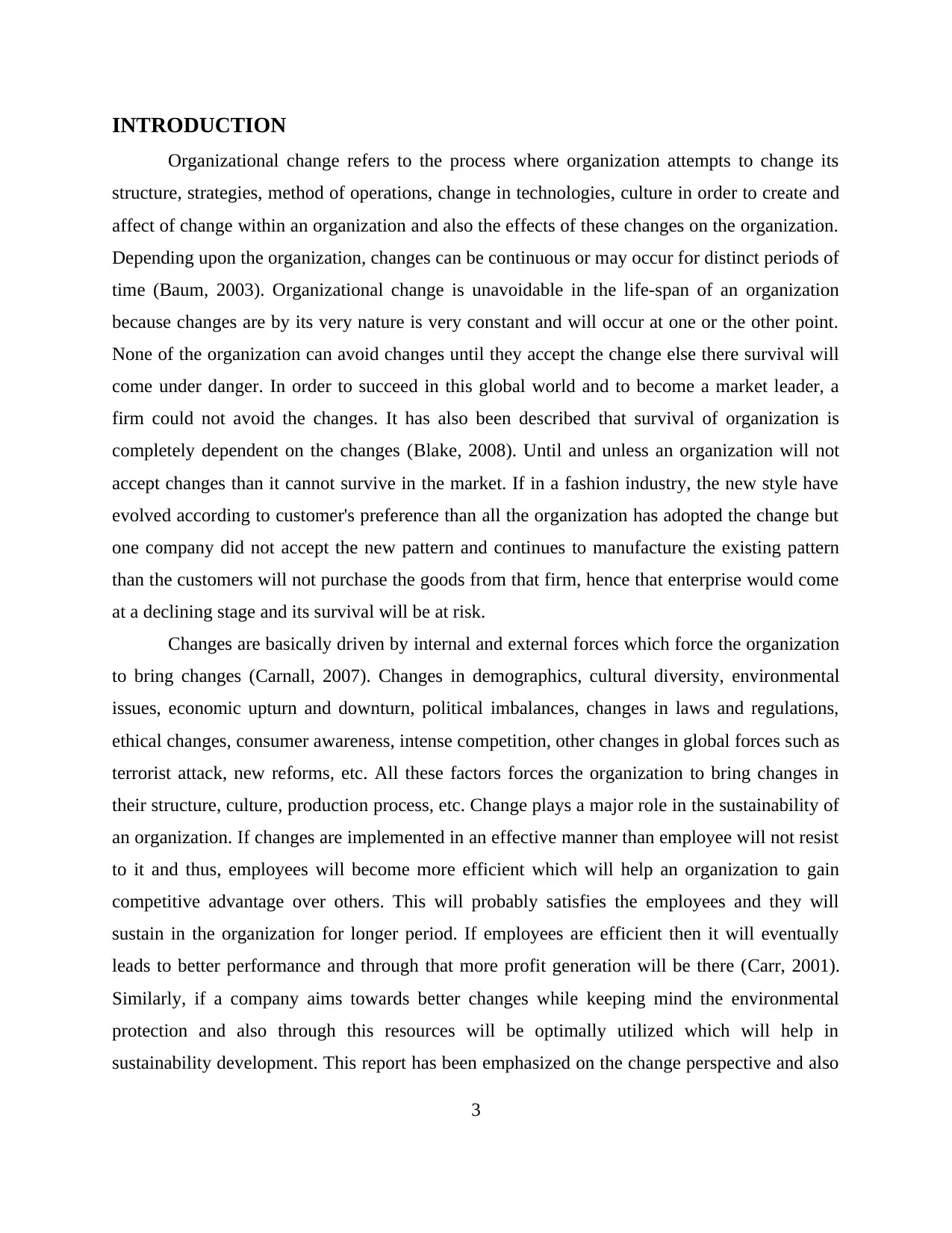
INTRODUCTION
Organizational change refers to the process where organization attempts to change its
structure, strategies, method of operations, change in technologies, culture in order to create and
affect of change within an organization and also the effects of these changes on the organization.
Depending upon the organization, changes can be continuous or may occur for distinct periods of
time (Baum, 2003). Organizational change is unavoidable in the life-span of an organization
because changes are by its very nature is very constant and will occur at one or the other point.
None of the organization can avoid changes until they accept the change else there survival will
come under danger. In order to succeed in this global world and to become a market leader, a
firm could not avoid the changes. It has also been described that survival of organization is
completely dependent on the changes (Blake, 2008). Until and unless an organization will not
accept changes than it cannot survive in the market. If in a fashion industry, the new style have
evolved according to customer's preference than all the organization has adopted the change but
one company did not accept the new pattern and continues to manufacture the existing pattern
than the customers will not purchase the goods from that firm, hence that enterprise would come
at a declining stage and its survival will be at risk.
Changes are basically driven by internal and external forces which force the organization
to bring changes (Carnall, 2007). Changes in demographics, cultural diversity, environmental
issues, economic upturn and downturn, political imbalances, changes in laws and regulations,
ethical changes, consumer awareness, intense competition, other changes in global forces such as
terrorist attack, new reforms, etc. All these factors forces the organization to bring changes in
their structure, culture, production process, etc. Change plays a major role in the sustainability of
an organization. If changes are implemented in an effective manner than employee will not resist
to it and thus, employees will become more efficient which will help an organization to gain
competitive advantage over others. This will probably satisfies the employees and they will
sustain in the organization for longer period. If employees are efficient then it will eventually
leads to better performance and through that more profit generation will be there (Carr, 2001).
Similarly, if a company aims towards better changes while keeping mind the environmental
protection and also through this resources will be optimally utilized which will help in
sustainability development. This report has been emphasized on the change perspective and also
3
Organizational change refers to the process where organization attempts to change its
structure, strategies, method of operations, change in technologies, culture in order to create and
affect of change within an organization and also the effects of these changes on the organization.
Depending upon the organization, changes can be continuous or may occur for distinct periods of
time (Baum, 2003). Organizational change is unavoidable in the life-span of an organization
because changes are by its very nature is very constant and will occur at one or the other point.
None of the organization can avoid changes until they accept the change else there survival will
come under danger. In order to succeed in this global world and to become a market leader, a
firm could not avoid the changes. It has also been described that survival of organization is
completely dependent on the changes (Blake, 2008). Until and unless an organization will not
accept changes than it cannot survive in the market. If in a fashion industry, the new style have
evolved according to customer's preference than all the organization has adopted the change but
one company did not accept the new pattern and continues to manufacture the existing pattern
than the customers will not purchase the goods from that firm, hence that enterprise would come
at a declining stage and its survival will be at risk.
Changes are basically driven by internal and external forces which force the organization
to bring changes (Carnall, 2007). Changes in demographics, cultural diversity, environmental
issues, economic upturn and downturn, political imbalances, changes in laws and regulations,
ethical changes, consumer awareness, intense competition, other changes in global forces such as
terrorist attack, new reforms, etc. All these factors forces the organization to bring changes in
their structure, culture, production process, etc. Change plays a major role in the sustainability of
an organization. If changes are implemented in an effective manner than employee will not resist
to it and thus, employees will become more efficient which will help an organization to gain
competitive advantage over others. This will probably satisfies the employees and they will
sustain in the organization for longer period. If employees are efficient then it will eventually
leads to better performance and through that more profit generation will be there (Carr, 2001).
Similarly, if a company aims towards better changes while keeping mind the environmental
protection and also through this resources will be optimally utilized which will help in
sustainability development. This report has been emphasized on the change perspective and also
3
⊘ This is a preview!⊘
Do you want full access?
Subscribe today to unlock all pages.

Trusted by 1+ million students worldwide
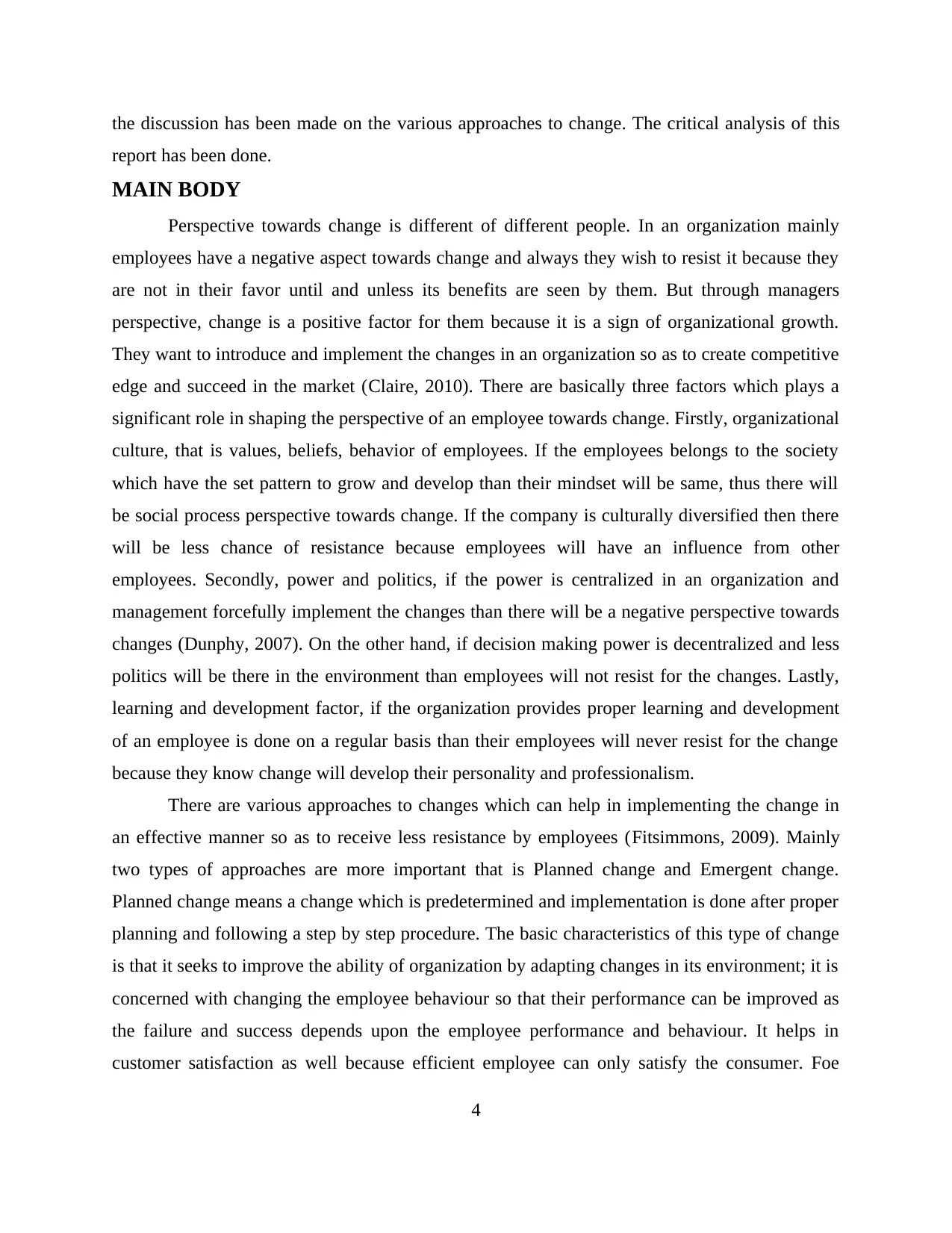
the discussion has been made on the various approaches to change. The critical analysis of this
report has been done.
MAIN BODY
Perspective towards change is different of different people. In an organization mainly
employees have a negative aspect towards change and always they wish to resist it because they
are not in their favor until and unless its benefits are seen by them. But through managers
perspective, change is a positive factor for them because it is a sign of organizational growth.
They want to introduce and implement the changes in an organization so as to create competitive
edge and succeed in the market (Claire, 2010). There are basically three factors which plays a
significant role in shaping the perspective of an employee towards change. Firstly, organizational
culture, that is values, beliefs, behavior of employees. If the employees belongs to the society
which have the set pattern to grow and develop than their mindset will be same, thus there will
be social process perspective towards change. If the company is culturally diversified then there
will be less chance of resistance because employees will have an influence from other
employees. Secondly, power and politics, if the power is centralized in an organization and
management forcefully implement the changes than there will be a negative perspective towards
changes (Dunphy, 2007). On the other hand, if decision making power is decentralized and less
politics will be there in the environment than employees will not resist for the changes. Lastly,
learning and development factor, if the organization provides proper learning and development
of an employee is done on a regular basis than their employees will never resist for the change
because they know change will develop their personality and professionalism.
There are various approaches to changes which can help in implementing the change in
an effective manner so as to receive less resistance by employees (Fitsimmons, 2009). Mainly
two types of approaches are more important that is Planned change and Emergent change.
Planned change means a change which is predetermined and implementation is done after proper
planning and following a step by step procedure. The basic characteristics of this type of change
is that it seeks to improve the ability of organization by adapting changes in its environment; it is
concerned with changing the employee behaviour so that their performance can be improved as
the failure and success depends upon the employee performance and behaviour. It helps in
customer satisfaction as well because efficient employee can only satisfy the consumer. Foe
4
report has been done.
MAIN BODY
Perspective towards change is different of different people. In an organization mainly
employees have a negative aspect towards change and always they wish to resist it because they
are not in their favor until and unless its benefits are seen by them. But through managers
perspective, change is a positive factor for them because it is a sign of organizational growth.
They want to introduce and implement the changes in an organization so as to create competitive
edge and succeed in the market (Claire, 2010). There are basically three factors which plays a
significant role in shaping the perspective of an employee towards change. Firstly, organizational
culture, that is values, beliefs, behavior of employees. If the employees belongs to the society
which have the set pattern to grow and develop than their mindset will be same, thus there will
be social process perspective towards change. If the company is culturally diversified then there
will be less chance of resistance because employees will have an influence from other
employees. Secondly, power and politics, if the power is centralized in an organization and
management forcefully implement the changes than there will be a negative perspective towards
changes (Dunphy, 2007). On the other hand, if decision making power is decentralized and less
politics will be there in the environment than employees will not resist for the changes. Lastly,
learning and development factor, if the organization provides proper learning and development
of an employee is done on a regular basis than their employees will never resist for the change
because they know change will develop their personality and professionalism.
There are various approaches to changes which can help in implementing the change in
an effective manner so as to receive less resistance by employees (Fitsimmons, 2009). Mainly
two types of approaches are more important that is Planned change and Emergent change.
Planned change means a change which is predetermined and implementation is done after proper
planning and following a step by step procedure. The basic characteristics of this type of change
is that it seeks to improve the ability of organization by adapting changes in its environment; it is
concerned with changing the employee behaviour so that their performance can be improved as
the failure and success depends upon the employee performance and behaviour. It helps in
customer satisfaction as well because efficient employee can only satisfy the consumer. Foe
4
Paraphrase This Document
Need a fresh take? Get an instant paraphrase of this document with our AI Paraphraser
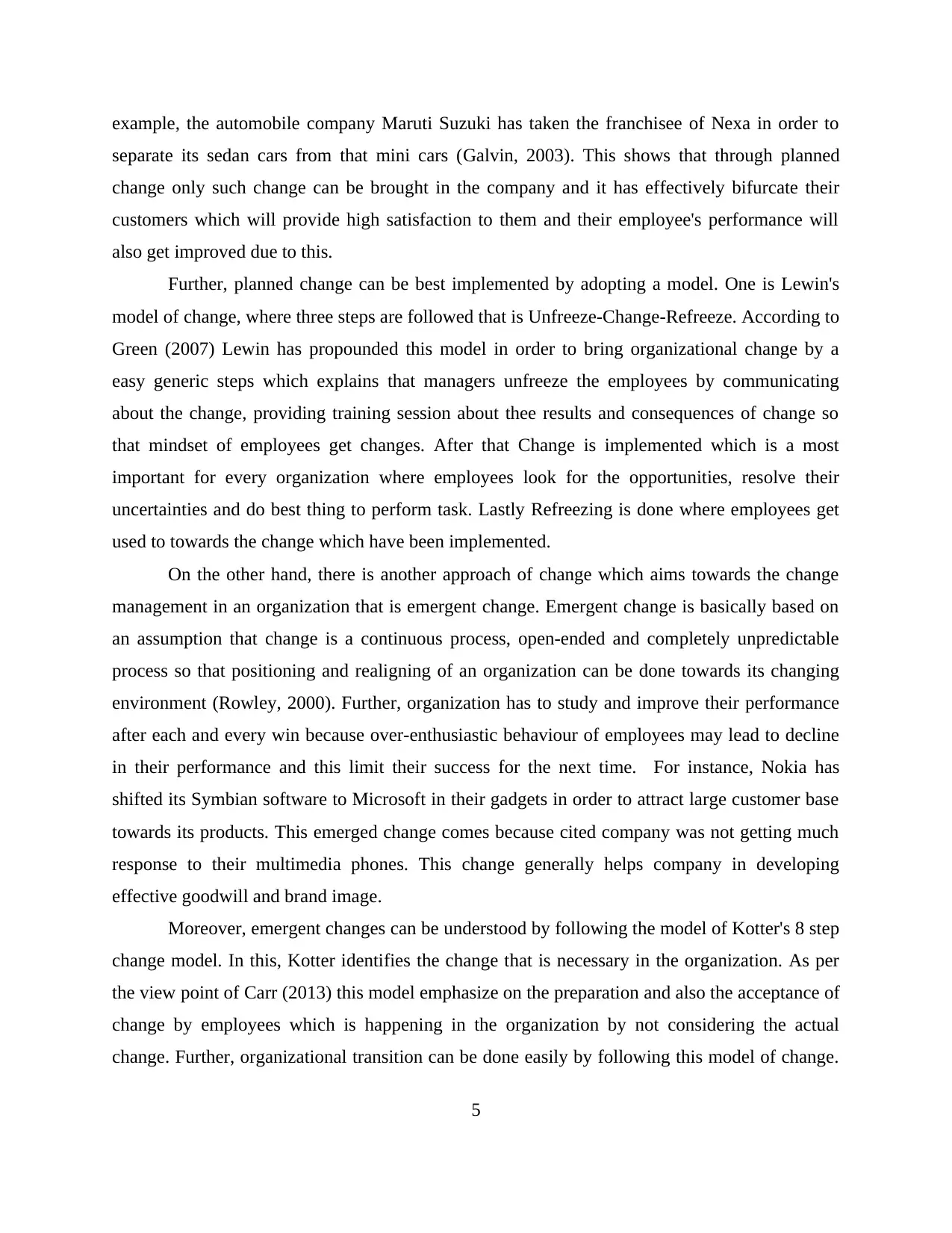
example, the automobile company Maruti Suzuki has taken the franchisee of Nexa in order to
separate its sedan cars from that mini cars (Galvin, 2003). This shows that through planned
change only such change can be brought in the company and it has effectively bifurcate their
customers which will provide high satisfaction to them and their employee's performance will
also get improved due to this.
Further, planned change can be best implemented by adopting a model. One is Lewin's
model of change, where three steps are followed that is Unfreeze-Change-Refreeze. According to
Green (2007) Lewin has propounded this model in order to bring organizational change by a
easy generic steps which explains that managers unfreeze the employees by communicating
about the change, providing training session about thee results and consequences of change so
that mindset of employees get changes. After that Change is implemented which is a most
important for every organization where employees look for the opportunities, resolve their
uncertainties and do best thing to perform task. Lastly Refreezing is done where employees get
used to towards the change which have been implemented.
On the other hand, there is another approach of change which aims towards the change
management in an organization that is emergent change. Emergent change is basically based on
an assumption that change is a continuous process, open-ended and completely unpredictable
process so that positioning and realigning of an organization can be done towards its changing
environment (Rowley, 2000). Further, organization has to study and improve their performance
after each and every win because over-enthusiastic behaviour of employees may lead to decline
in their performance and this limit their success for the next time. For instance, Nokia has
shifted its Symbian software to Microsoft in their gadgets in order to attract large customer base
towards its products. This emerged change comes because cited company was not getting much
response to their multimedia phones. This change generally helps company in developing
effective goodwill and brand image.
Moreover, emergent changes can be understood by following the model of Kotter's 8 step
change model. In this, Kotter identifies the change that is necessary in the organization. As per
the view point of Carr (2013) this model emphasize on the preparation and also the acceptance of
change by employees which is happening in the organization by not considering the actual
change. Further, organizational transition can be done easily by following this model of change.
5
separate its sedan cars from that mini cars (Galvin, 2003). This shows that through planned
change only such change can be brought in the company and it has effectively bifurcate their
customers which will provide high satisfaction to them and their employee's performance will
also get improved due to this.
Further, planned change can be best implemented by adopting a model. One is Lewin's
model of change, where three steps are followed that is Unfreeze-Change-Refreeze. According to
Green (2007) Lewin has propounded this model in order to bring organizational change by a
easy generic steps which explains that managers unfreeze the employees by communicating
about the change, providing training session about thee results and consequences of change so
that mindset of employees get changes. After that Change is implemented which is a most
important for every organization where employees look for the opportunities, resolve their
uncertainties and do best thing to perform task. Lastly Refreezing is done where employees get
used to towards the change which have been implemented.
On the other hand, there is another approach of change which aims towards the change
management in an organization that is emergent change. Emergent change is basically based on
an assumption that change is a continuous process, open-ended and completely unpredictable
process so that positioning and realigning of an organization can be done towards its changing
environment (Rowley, 2000). Further, organization has to study and improve their performance
after each and every win because over-enthusiastic behaviour of employees may lead to decline
in their performance and this limit their success for the next time. For instance, Nokia has
shifted its Symbian software to Microsoft in their gadgets in order to attract large customer base
towards its products. This emerged change comes because cited company was not getting much
response to their multimedia phones. This change generally helps company in developing
effective goodwill and brand image.
Moreover, emergent changes can be understood by following the model of Kotter's 8 step
change model. In this, Kotter identifies the change that is necessary in the organization. As per
the view point of Carr (2013) this model emphasize on the preparation and also the acceptance of
change by employees which is happening in the organization by not considering the actual
change. Further, organizational transition can be done easily by following this model of change.
5
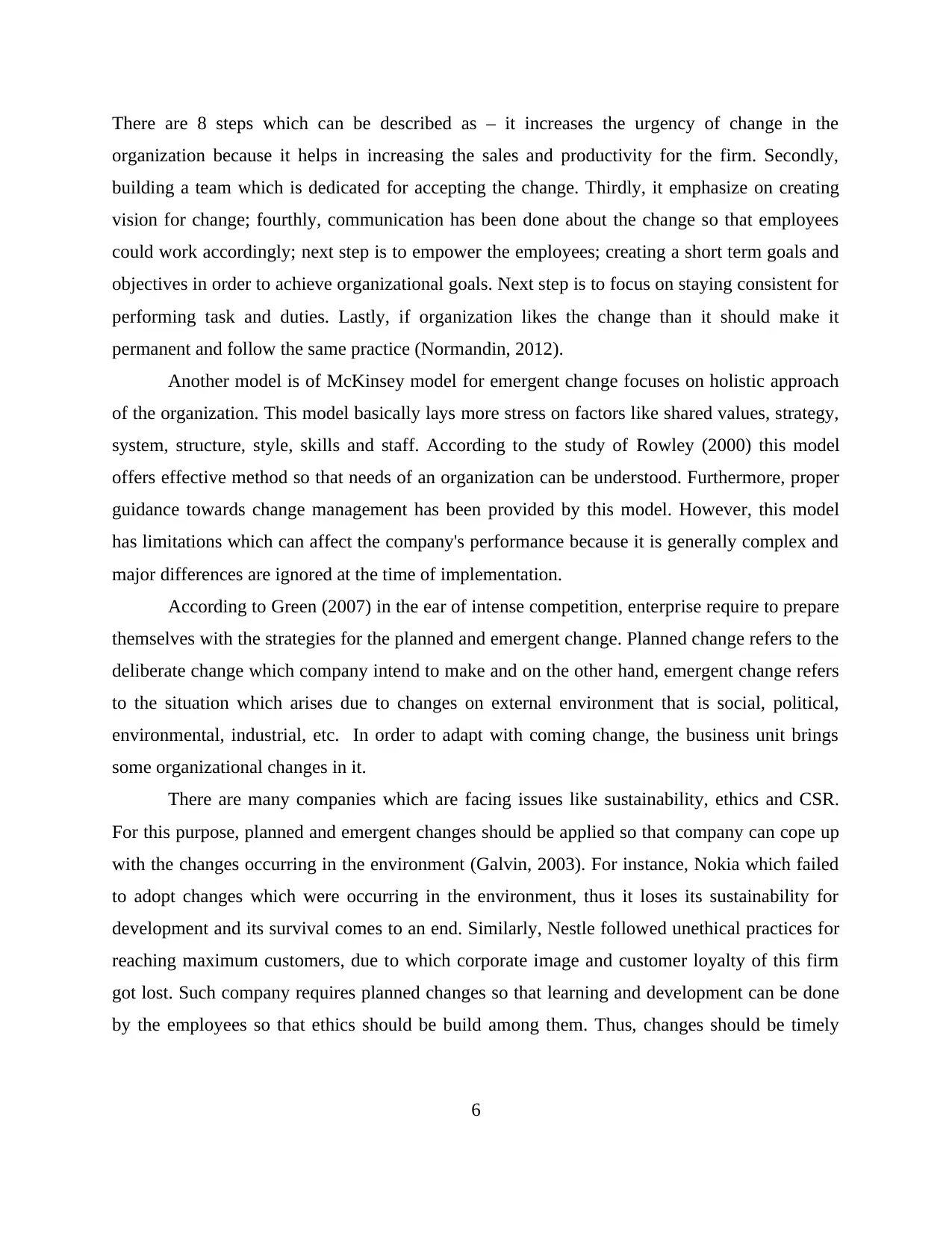
There are 8 steps which can be described as – it increases the urgency of change in the
organization because it helps in increasing the sales and productivity for the firm. Secondly,
building a team which is dedicated for accepting the change. Thirdly, it emphasize on creating
vision for change; fourthly, communication has been done about the change so that employees
could work accordingly; next step is to empower the employees; creating a short term goals and
objectives in order to achieve organizational goals. Next step is to focus on staying consistent for
performing task and duties. Lastly, if organization likes the change than it should make it
permanent and follow the same practice (Normandin, 2012).
Another model is of McKinsey model for emergent change focuses on holistic approach
of the organization. This model basically lays more stress on factors like shared values, strategy,
system, structure, style, skills and staff. According to the study of Rowley (2000) this model
offers effective method so that needs of an organization can be understood. Furthermore, proper
guidance towards change management has been provided by this model. However, this model
has limitations which can affect the company's performance because it is generally complex and
major differences are ignored at the time of implementation.
According to Green (2007) in the ear of intense competition, enterprise require to prepare
themselves with the strategies for the planned and emergent change. Planned change refers to the
deliberate change which company intend to make and on the other hand, emergent change refers
to the situation which arises due to changes on external environment that is social, political,
environmental, industrial, etc. In order to adapt with coming change, the business unit brings
some organizational changes in it.
There are many companies which are facing issues like sustainability, ethics and CSR.
For this purpose, planned and emergent changes should be applied so that company can cope up
with the changes occurring in the environment (Galvin, 2003). For instance, Nokia which failed
to adopt changes which were occurring in the environment, thus it loses its sustainability for
development and its survival comes to an end. Similarly, Nestle followed unethical practices for
reaching maximum customers, due to which corporate image and customer loyalty of this firm
got lost. Such company requires planned changes so that learning and development can be done
by the employees so that ethics should be build among them. Thus, changes should be timely
6
organization because it helps in increasing the sales and productivity for the firm. Secondly,
building a team which is dedicated for accepting the change. Thirdly, it emphasize on creating
vision for change; fourthly, communication has been done about the change so that employees
could work accordingly; next step is to empower the employees; creating a short term goals and
objectives in order to achieve organizational goals. Next step is to focus on staying consistent for
performing task and duties. Lastly, if organization likes the change than it should make it
permanent and follow the same practice (Normandin, 2012).
Another model is of McKinsey model for emergent change focuses on holistic approach
of the organization. This model basically lays more stress on factors like shared values, strategy,
system, structure, style, skills and staff. According to the study of Rowley (2000) this model
offers effective method so that needs of an organization can be understood. Furthermore, proper
guidance towards change management has been provided by this model. However, this model
has limitations which can affect the company's performance because it is generally complex and
major differences are ignored at the time of implementation.
According to Green (2007) in the ear of intense competition, enterprise require to prepare
themselves with the strategies for the planned and emergent change. Planned change refers to the
deliberate change which company intend to make and on the other hand, emergent change refers
to the situation which arises due to changes on external environment that is social, political,
environmental, industrial, etc. In order to adapt with coming change, the business unit brings
some organizational changes in it.
There are many companies which are facing issues like sustainability, ethics and CSR.
For this purpose, planned and emergent changes should be applied so that company can cope up
with the changes occurring in the environment (Galvin, 2003). For instance, Nokia which failed
to adopt changes which were occurring in the environment, thus it loses its sustainability for
development and its survival comes to an end. Similarly, Nestle followed unethical practices for
reaching maximum customers, due to which corporate image and customer loyalty of this firm
got lost. Such company requires planned changes so that learning and development can be done
by the employees so that ethics should be build among them. Thus, changes should be timely
6
⊘ This is a preview!⊘
Do you want full access?
Subscribe today to unlock all pages.

Trusted by 1+ million students worldwide
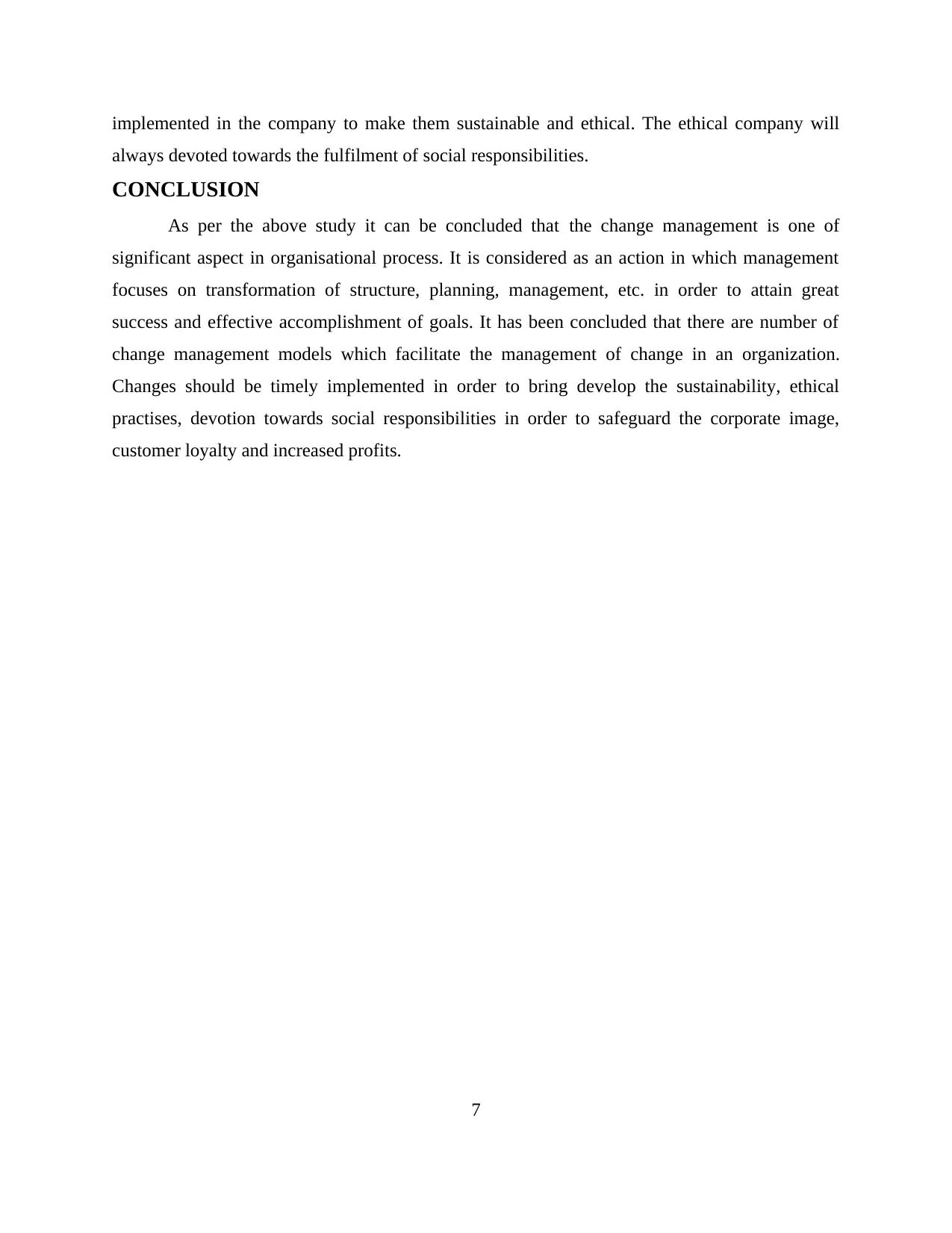
implemented in the company to make them sustainable and ethical. The ethical company will
always devoted towards the fulfilment of social responsibilities.
CONCLUSION
As per the above study it can be concluded that the change management is one of
significant aspect in organisational process. It is considered as an action in which management
focuses on transformation of structure, planning, management, etc. in order to attain great
success and effective accomplishment of goals. It has been concluded that there are number of
change management models which facilitate the management of change in an organization.
Changes should be timely implemented in order to bring develop the sustainability, ethical
practises, devotion towards social responsibilities in order to safeguard the corporate image,
customer loyalty and increased profits.
7
always devoted towards the fulfilment of social responsibilities.
CONCLUSION
As per the above study it can be concluded that the change management is one of
significant aspect in organisational process. It is considered as an action in which management
focuses on transformation of structure, planning, management, etc. in order to attain great
success and effective accomplishment of goals. It has been concluded that there are number of
change management models which facilitate the management of change in an organization.
Changes should be timely implemented in order to bring develop the sustainability, ethical
practises, devotion towards social responsibilities in order to safeguard the corporate image,
customer loyalty and increased profits.
7
Paraphrase This Document
Need a fresh take? Get an instant paraphrase of this document with our AI Paraphraser
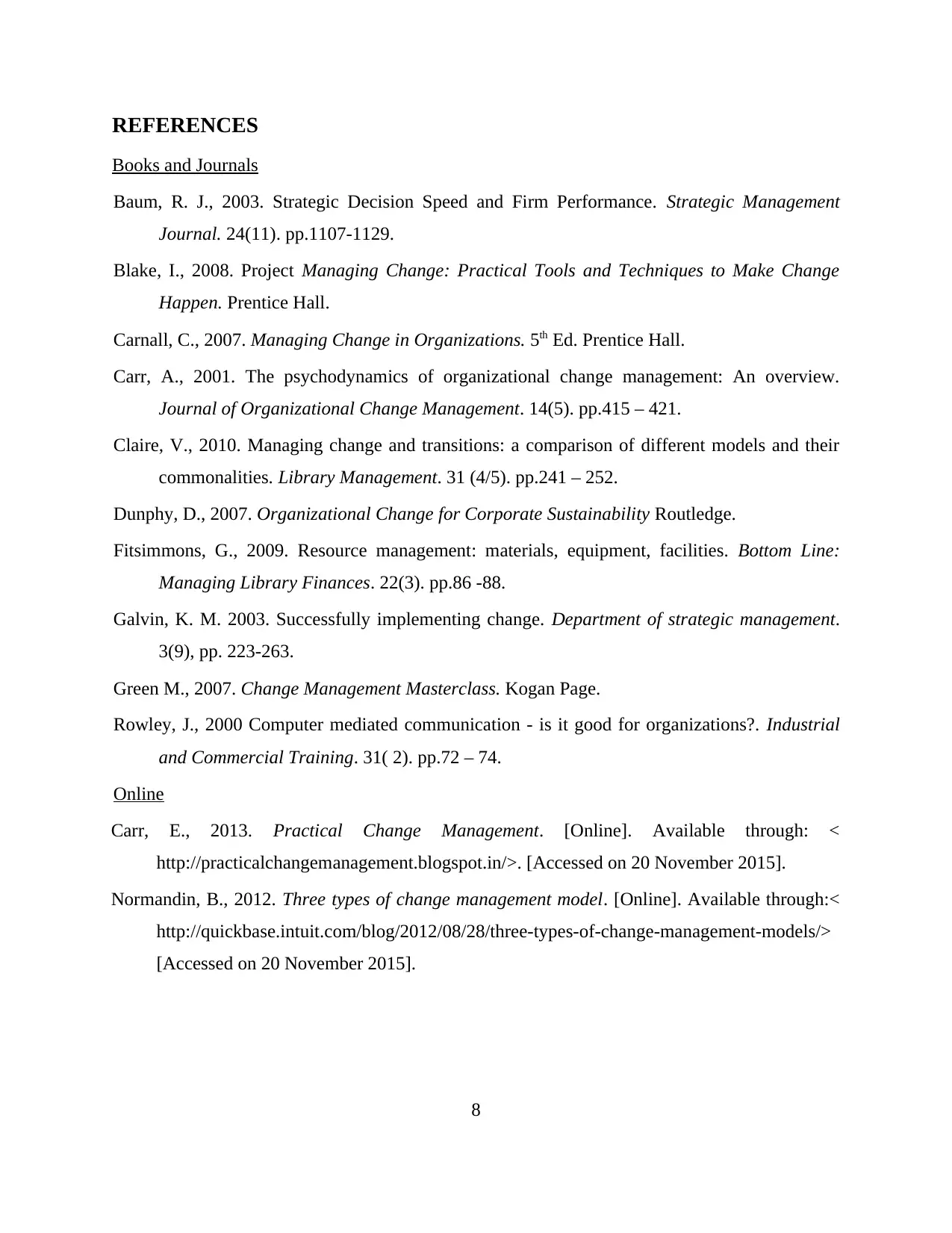
REFERENCES
Books and Journals
Baum, R. J., 2003. Strategic Decision Speed and Firm Performance. Strategic Management
Journal. 24(11). pp.1107-1129.
Blake, I., 2008. Project Managing Change: Practical Tools and Techniques to Make Change
Happen. Prentice Hall.
Carnall, C., 2007. Managing Change in Organizations. 5th Ed. Prentice Hall.
Carr, A., 2001. The psychodynamics of organizational change management: An overview.
Journal of Organizational Change Management. 14(5). pp.415 – 421.
Claire, V., 2010. Managing change and transitions: a comparison of different models and their
commonalities. Library Management. 31 (4/5). pp.241 – 252.
Dunphy, D., 2007. Organizational Change for Corporate Sustainability Routledge.
Fitsimmons, G., 2009. Resource management: materials, equipment, facilities. Bottom Line:
Managing Library Finances. 22(3). pp.86 -88.
Galvin, K. M. 2003. Successfully implementing change. Department of strategic management.
3(9), pp. 223-263.
Green M., 2007. Change Management Masterclass. Kogan Page.
Rowley, J., 2000 Computer mediated communication - is it good for organizations?. Industrial
and Commercial Training. 31( 2). pp.72 – 74.
Online
Carr, E., 2013. Practical Change Management. [Online]. Available through: <
http://practicalchangemanagement.blogspot.in/>. [Accessed on 20 November 2015].
Normandin, B., 2012. Three types of change management model. [Online]. Available through:<
http://quickbase.intuit.com/blog/2012/08/28/three-types-of-change-management-models/>
[Accessed on 20 November 2015].
8
Books and Journals
Baum, R. J., 2003. Strategic Decision Speed and Firm Performance. Strategic Management
Journal. 24(11). pp.1107-1129.
Blake, I., 2008. Project Managing Change: Practical Tools and Techniques to Make Change
Happen. Prentice Hall.
Carnall, C., 2007. Managing Change in Organizations. 5th Ed. Prentice Hall.
Carr, A., 2001. The psychodynamics of organizational change management: An overview.
Journal of Organizational Change Management. 14(5). pp.415 – 421.
Claire, V., 2010. Managing change and transitions: a comparison of different models and their
commonalities. Library Management. 31 (4/5). pp.241 – 252.
Dunphy, D., 2007. Organizational Change for Corporate Sustainability Routledge.
Fitsimmons, G., 2009. Resource management: materials, equipment, facilities. Bottom Line:
Managing Library Finances. 22(3). pp.86 -88.
Galvin, K. M. 2003. Successfully implementing change. Department of strategic management.
3(9), pp. 223-263.
Green M., 2007. Change Management Masterclass. Kogan Page.
Rowley, J., 2000 Computer mediated communication - is it good for organizations?. Industrial
and Commercial Training. 31( 2). pp.72 – 74.
Online
Carr, E., 2013. Practical Change Management. [Online]. Available through: <
http://practicalchangemanagement.blogspot.in/>. [Accessed on 20 November 2015].
Normandin, B., 2012. Three types of change management model. [Online]. Available through:<
http://quickbase.intuit.com/blog/2012/08/28/three-types-of-change-management-models/>
[Accessed on 20 November 2015].
8
1 out of 8
Related Documents
Your All-in-One AI-Powered Toolkit for Academic Success.
+13062052269
info@desklib.com
Available 24*7 on WhatsApp / Email
![[object Object]](/_next/static/media/star-bottom.7253800d.svg)
Unlock your academic potential
Copyright © 2020–2025 A2Z Services. All Rights Reserved. Developed and managed by ZUCOL.





